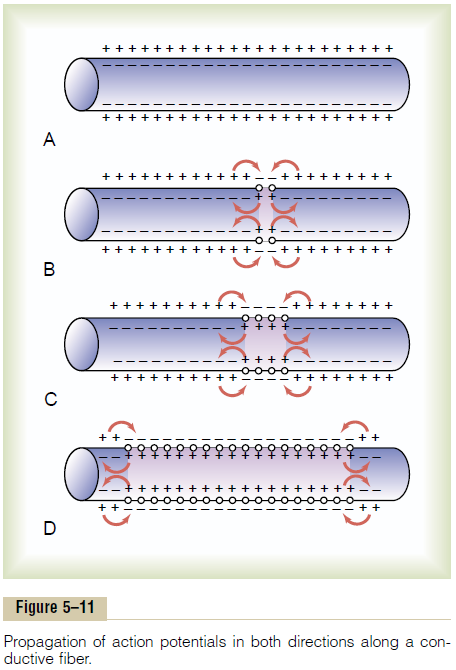Chapter: Medical Physiology: Membrane Physiology, Nerve, and Muscle : Membrane Potentials and Action Potentials
Propagation of the Action Potential
Propagation of the Action Potential
In the preceding , we discussed the action potential as it occurs at one spot on the membrane. However, an action potential elicited at any one point on an excitable membrane usually excites adjacent portions of the membrane, resulting in propagation of the action potential along the membrane. This mecha-nism is demonstrated in Figure 5–11. Figure 5–11A shows a normal resting nerve fiber, and Figure 5–11B shows a nerve fiber that has been excited in its mid-portion—that is, the midportion suddenly develops increased permeability to sodium. The arrows show a “local circuit” of current flow from the depolarized areas of the membrane to the adjacent resting mem-brane areas. That is, positive electrical charges are carried by the inward-diffusing sodium ions through the depolarized membrane and then for several mil-limeters in both directions along the core of the axon. These positive charges increase the voltage for a dis-tance of 1 to 3 millimeters inside the large myelinated

fiber to above the threshold voltage value for initiating an action potential. Therefore, the sodium channels in these new areas immediately open, as shown in Figure 5–11C and D, and the explosive action potential spreads. These newly depolarized areas produce still more local circuits of current flow farther along the membrane, causing progressively more and more depolarization. Thus, the depolarization process travels along the entire length of the fiber. This trans-mission of the depolarization process along a nerve or muscle fiber is called a nerve or muscle impulse.
Direction of Propagation. As demonstrated in Figure5–11, an excitable membrane has no single direction of propagation, but the action potential travels in all directions away from the stimulus—even along all branches of a nerve fiber—until the entire membrane has become depolarized.
All-or-Nothing Principle. Once an action potential hasbeen elicited at any point on the membrane of a normal fiber, the depolarization process travels over the entire membrane if conditions are right, or it does not travel at all if conditions are not right. This is called theall-or-nothing principle, and it applies to all normal excitable tissues. Occasionally, the action potential reaches a point on the membrane at which it does not generate sufficient voltage to stimulate the next area of the membrane. When this occurs, the spread of depolarization stops. Therefore, for continued propa-gation of an impulse to occur, the ratio of action poten-tial to threshold for excitation must at all times be greater than 1. This “greater than 1” requirement is called the safety factor for propagation.
Related Topics